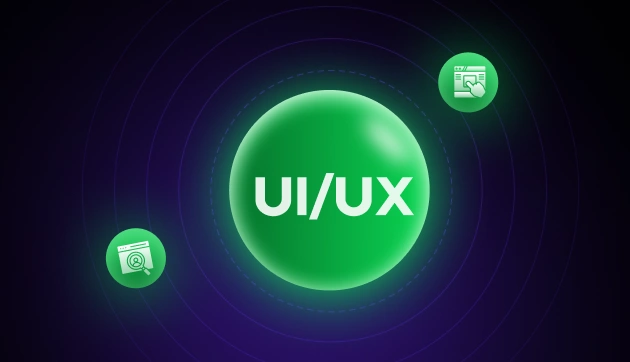![What Does a UI/UX Designer Do? [Career Guide] 1 Post thumbnail](https://www.guvi.in/blog/wp-content/uploads/2023/12/UX-Designer-Do_.webp)
What Does a UI/UX Designer Do? [Career Guide]
Mar 31, 2025 5 Min Read 4313 Views
(Last Updated)
What do you think is one of the most important parts of development but often overlooked? It is of course the design of the interface which is also called UI/UX design. UI/UX design is crucial in bridging the gap between technology and human interaction. These designers are the architects behind intuitive and visually engaging digital products that cater to users’ needs.
Their ability to create intuitive, visually captivating designs is critical as businesses compete to offer the best user experiences. As the demand for engaging digital products skyrockets, UI/UX design has evolved into a highly sought-after career that blends creativity with technical expertise.
This guide explores the vital role of UI/UX designers, shedding light on why this career is booming in this current digital era.
Table of contents
- What is UI/UX Design?
- What Is a UX Designer?
- What Does a UX Designer Do?
- What Is a UI Designer?
- What Does a UI Designer Do?
- Why Are UI/UX Designers Important for a Company?
- Key Skills for UI/UX Designers
- Technical and Creative Skills Breakdown:
- Additional Skills:
- Salary Insights and Career Outlook for UI/UX Designers in India
- Average Salaries in India:
- Career Progression for UI/UX Designers
- What Companies Expect from a UI/UX Designer?
- User-Centered Thinking & Empathy
- Business Awareness & Problem-Solving
- Strong Communication & Collaboration Skills
- Design Process Ownership
- A Balance of Creativity and Consistency
- A Portfolio That Shows Thinking, Not Just Pretty Screens
- Concluding Thoughts…
- FAQs
- What are the works of a UI/UX designer?
- Does UI/UX require coding?
- Should I learn UI or UX first?
- Which language is used in UI/UX?
- Which software is used in UI/UX?
What is UI/UX Design?
UI (User Interface) and UX (User Experience) design work together to create products that are both visually appealing and user-friendly. In today’s digital era, UI/UX design is more relevant than ever due to the explosion of digital platforms and the need for seamless user interactions.
It is important to note that UI and UX are complementary but distinct areas of design, often overlapping but requiring specialized skills to master.
What Is a UX Designer?
A User Experience (UX) Designer is responsible for how a product feels to the user. Their focus is on the overall experience, from the moment a user lands on an app or website to how easily they can complete their intended task.
UX designers study user behavior, understand their pain points, and create solutions that are efficient, accessible, and satisfying. They ensure the product is not only functional but also delightful to use.
What Does a UX Designer Do?
Here are some of the key responsibilities of a UX designer:
- User Research: Understanding the target audience through interviews, surveys, and analytics.
- User Journey Mapping: Visualizing how users interact with a product and identifying friction points.
- Wireframing & Prototyping: Creating low- to high-fidelity sketches to test ideas before development.
- Usability Testing: Observing users interact with the product and gathering feedback for improvements.
- Collaboration: Working closely with product managers, developers, and UI designers to bring ideas to life.
A UX designer is, in many ways, the advocate for the user within a product team.
What Is a UI Designer?
A User Interface (UI) Designer is responsible for how a product looks. They design the visual components of a product—buttons, color schemes, typography, layout, icons, and animations. Their job is to translate the UX designer’s blueprint into a visually appealing and intuitive interface.
What Does a UI Designer Do?
A UI designer’s role includes:
- Visual Design: Crafting layouts, illustrations, and visuals that match the brand’s identity.
- Interaction Design: Designing interactive elements like buttons, menus, sliders, etc.
- Design Systems: Creating and maintaining consistent design guidelines and reusable components.
- Accessibility Design: Ensuring the interface is usable by people with varying abilities (e.g., color contrast, font sizes).
- Prototyping Tools: Using software like Figma, Adobe XD, or Sketch to design and present interfaces.
Think of UI design as the layer you see and touch while UX design is the invisible architecture that supports it.
To summarize, the role and focus of UI and UX designers are:
![What Does a UI/UX Designer Do? [Career Guide] 2 UI/UX](https://www.guvi.in/blog/wp-content/uploads/2024/10/UI_vs_UX-1200x630.png)
| Role | Key Focus | Core Responsibilities |
| UI Designer | Visual design, branding, interactivity | Creating design systems, wireframes, high-fidelity prototypes, and collaborating with devs |
| UX Designer | User experience, behavior, and usability | Conducting user research, creating personas, prototyping, usability testing |
Why Are UI/UX Designers Important for a Company?
![What Does a UI/UX Designer Do? [Career Guide] 3 Why Are UI/UX Designers Important for a Company?](https://www.guvi.in/blog/wp-content/uploads/2025/03/UX-Designers-Are-Important-for-a-Company-1200x630.webp)
In an age where users have endless options, your product’s design is often its first impression and sometimes, the only one you get.
Here’s why UI/UX designers are business-critical:
- User Retention: A seamless experience increases engagement and reduces drop-offs.
- Conversion Optimization: Thoughtfully designed interfaces can significantly improve sign-ups, purchases, or other key actions.
- Brand Perception: A polished, consistent design reflects professionalism and builds trust.
- Reduced Development Costs: Early prototyping and testing can save time and resources in the long run.
- Customer-Centric Approach: UX research ensures the product solves real user problems—not just assumptions.
When you invest in UI/UX design, you’re not just making your product look good—you’re making it work better, too.
Key Skills for UI/UX Designers
UI/UX designers must possess a robust combination of creative and technical skills to design products that are both attractive and functional. Let’s explore the essential skills needed in today’s UI/UX landscape:
Technical and Creative Skills Breakdown:
| Skill | UI Designer | UX Designer |
| Design Tools | Figma, Sketch, Adobe XD, Photoshop | Figma, Axure, InVision, Balsamiq for wireframing |
| Prototyping Tools | InVision, Zeplin, Marvel | Maze, Optimal Workshop, Marvel |
| Visual Design | Color theory, typography, layout | N/A (Focus on user behavior and flows) |
| User Research | N/A | Conducting interviews, surveys, analyzing user behavior |
| Information Architecture | N/A | Structuring content logically for smooth navigation |
| Collaboration & Handoff | Handoff design specs to developers | Testing, gathering feedback, iterative improvements |
Additional Skills:
- Problem-Solving Abilities: Both UI and UX designers need to solve user and business problems, balancing design aesthetics with practical functionality.
- Attention to Detail: UI designers must focus on pixel-perfect designs, while UX designers emphasize the details of user journeys and interactions.
Communication Skills: Whether explaining a design concept to a stakeholder or conducting user interviews, effective communication is essential in both roles.
In case you want to read more about UI/UX designing from scratch and become well-equipped with the domain, consider reading GUVI’s Fundamentals of UI/UX Ebook that covers the key concepts of UI/UX (like color theory, typography, and spacing) and the core principles of UI/UX along with UX design process.
Salary Insights and Career Outlook for UI/UX Designers in India
![What Does a UI/UX Designer Do? [Career Guide] 4 Salary Insights and Career Outlook for UI/UX Designers in India](https://www.guvi.in/blog/wp-content/uploads/2025/03/UX-Designers-in-India-1200x630.webp)
The demand for skilled UI/UX designers in India has grown significantly with the rise of digital-first businesses, startups, and global tech expansion.
Average Salaries in India:
| Experience Level | Role | Avg. Annual Salary (INR) |
| 0-2 years | UI/UX Designer | ₹4.5 – ₹7 LPA |
| 2-5 years | Product Designer | ₹8 – ₹14 LPA |
| 5+ years | Lead UX Designer | ₹15 – ₹25+ LPA |
Note: Salaries may vary depending on the company, location, and skill set.
Career Progression for UI/UX Designers
UI/UX designers have numerous opportunities for career growth, moving from hands-on design roles to strategic leadership positions. Here’s a deeper look at the typical career path:
| Career Level | Key Responsibilities | Required Skills | Salary (India) |
| Junior Designer | Assisting in design creation, wireframing, and developer handoffs | Proficiency in design tools, basic prototyping skills | ₹3LPA – ₹6LPA |
| Mid-Level Designer | Managing projects, conducting user research, leading design decisions | Advanced research and design thinking skills | ₹6LPA – ₹12LPA |
| Senior Designer | Defining design strategy, managing teams, and ensuring consistency across products | Leadership, communication, strategic thinking | ₹12LPA – ₹20LPA |
| UI/UX Manager | Overseeing a team of designers, aligning design with business goals | Team management, design leadership, cross-functional collaboration | ₹15LPA – ₹25LPA |
At senior levels, designers often transition into roles that influence product strategy, team management, and stakeholder engagement.
What Companies Expect from a UI/UX Designer?
![What Does a UI/UX Designer Do? [Career Guide] 6 What Companies Expect from a UI/UX Designer?](https://www.guvi.in/blog/wp-content/uploads/2025/03/UX-Designer-1200x630.webp)
When companies hire a UI/UX designer, they’re not just looking for someone who can make things “look good.” They want a strategic thinker who can contribute to business growth by creating intuitive, user-friendly, and efficient digital experiences.
Here’s a closer look at what that means:
1. User-Centered Thinking & Empathy
At the heart of every great product is a deep understanding of the user. Companies expect you to:
- Prioritize the user’s needs over your personal design preferences.
- Conduct and synthesize user research to discover pain points and goals.
- Use empathy to create solutions that are inclusive, accessible, and usable by real people—across various demographics and device types.
2. Business Awareness & Problem-Solving
Designs must solve real business problems. Companies expect you to:
- Understand the product’s goals, target audience, and KPIs.
- Think beyond aesthetics to create functional designs that improve conversions, retention, or engagement.
- Translate business challenges into user-friendly design strategies.
3. Strong Communication & Collaboration Skills
UI/UX designers never work in a silo. You’ll often work with:
- Developers who build your designs.
- Product managers who define goals and priorities.
- Stakeholders who want to see the value of design in business terms.
Companies expect you to:
- Explain design decisions clearly—with logic and evidence, not just preference.
- Collaborate with cross-functional teams, give and receive feedback maturely.
- Document and present your design process in a way that builds buy-in and trust.
4. Design Process Ownership
From discovery to delivery, companies want designers who can own the full cycle, which includes:
- Conducting user research or working with researchers.
- Sketching and wireframing ideas.
- Prototyping and validating solutions with real users.
- Iterating based on feedback and usability testing.
- Handoff to developers with clarity (design specs, components, behaviors).
5. A Balance of Creativity and Consistency
Yes, creativity is important but in a business context, so is brand consistency and scalability.
Companies expect you to:
- Be creative within constraints—brand guidelines, design systems, accessibility laws, etc.
- Contribute to or maintain a design system to ensure consistency across the product.
- Propose innovative solutions that don’t compromise usability or performance.
6. A Portfolio That Shows Thinking, Not Just Pretty Screens
Design managers and recruiters want to see:
- Case studies that walk through the problem, process, and solution.
- Wireframes, user flows, feedback iterations—not just polished UI.
- The impact of your work—metrics, feedback, or business outcomes.
Learn More: How to Create a UI UX Design Portfolio: Top 3 Essential Tips
When you apply for a UI/UX role, think of yourself not just as a designer but as a product thinker, user advocate, and business partner.
In short, companies expect UI/UX designers to:
- Be user-obsessed but business-aware
- Solve problems, not just deliver screens
- Collaborate well with diverse teams
- Own the process from research to handoff
- Communicate ideas clearly and persuasively
- Keep learning and evolving with the industry
If you can demonstrate these capabilities through your work, mindset, and communication you’ll stand out in any UI/UX hiring process.
If you want to kickstart your UI/UX journey and learn everything there is to about UI/UX design, consider enrolling in GUVI’s UI/UX Design Course, where you will master the most trending design tools, focusing on industry expectations and directing you to Fortune 500 companies.
Concluding Thoughts…
UI/UX design is a thriving career path, driven by the ever-increasing demand for user-centric digital products. UI/UX designers not only ensure that digital interfaces are visually appealing but also ensure that they provide seamless, intuitive experiences for users.
By mastering the required skills, tools, and processes, UI/UX designers are key players in shaping the future of human-computer interaction.
I hope this guide has helped you gain a thorough understanding of UI/UX design, from its core responsibilities to the necessary skills and tools, making it an indispensable career option. Do let us know what you thought of this article in the comments section below.
FAQs
UI/UX designers create intuitive and engaging user interfaces, conduct user research, design wireframes, and prototypes, and ensure a seamless user experience.
Basic coding knowledge can be helpful but is not mandatory for UI/UX design. Designers primarily focus on visuals and user interaction.
It’s best to start with UX design as it covers user research and experience, which provides a foundation before focusing on UI design aesthetics.
UI/UX design doesn’t require a specific programming language, but HTML, CSS, and JavaScript are commonly used for front-end implementation.
Popular tools include Figma, Adobe XD, Sketch, and InVision for designing and prototyping interfaces.



















Did you enjoy this article?